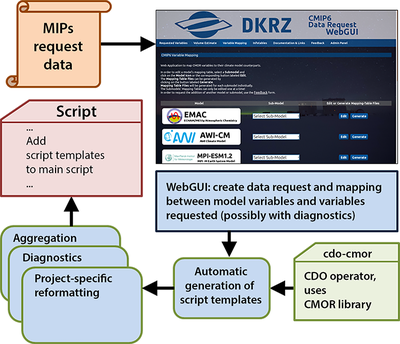The assessment reports of the Intergovernmental Panel on Climate Change (IPCC) are an important resource for policymakers because they document the current state of knowledge of the climate system and climate change. In 2021, part one out of three of the 6th assessment report is due for publication. This part will cover the scientific basis. Most of the statements on possible future climate change are based on results from climate simulations that were coordinated by the World Climate Research Programme (WCRP) within the scope of the “Coupled Model Intercomparison Project" (CMIP) to contribute to the report. Numerous international research groups have contributed to this model intercomparison with their own models and simulations.
 Germany’s contribution to the current model intercomparison CMIP6 (CMIP6 Landscape, 2019) has been funded by the German Federal Ministry of Education and Research (BMBF) and covers the entire process from preparing and setting up climate simulations to publishing the results. Over the past years, scientists of MPI-M, AWI, DLR, DWD and DKRZ have conducted a multitude of CMIP6 experiments and have standardized and published the output data via the ESGF (Earth System Grid Federation) data node at DKRZ. In the year 2019 alone, those simulations consumed about 1.2 million node hours of compute time at DKRZ. A total of 13,000 model years has been simulated within this scope.
Germany’s contribution to the current model intercomparison CMIP6 (CMIP6 Landscape, 2019) has been funded by the German Federal Ministry of Education and Research (BMBF) and covers the entire process from preparing and setting up climate simulations to publishing the results. Over the past years, scientists of MPI-M, AWI, DLR, DWD and DKRZ have conducted a multitude of CMIP6 experiments and have standardized and published the output data via the ESGF (Earth System Grid Federation) data node at DKRZ. In the year 2019 alone, those simulations consumed about 1.2 million node hours of compute time at DKRZ. A total of 13,000 model years has been simulated within this scope.
Both the earth system model MPI-ESM1.2 of the Max Planck Institute for Meteorology (MPI-M) (Mauritsen et al., 2019) and the climate model AWI-CM-1-1 of the Alfred Wegener Institute for Polar and Marine Research (Semmler et al., 2019) have benefitted in particular from the specifically-developed web-based post-processing infrastructure (see figure above).
By the end of April 2020, the CMIP6 data pool at DKRZ contained approximately 1.1 petabytes of quality-checked, published primary data. Another 2.1 petabytes were comprised of replicated climate model data, i.e. copies of simulation results provided by institutes in other countries. Scientists analyze these data sets using tools such as the ESMValTool (Earth System Model Evaluation Tool; Righi et. al, 2020), which contains established diagnostics of the model data and allows scientists to examine models with regard to their representation of important climate variables and processes. The results of the ESMValTool are made available to researchers on a website at DKRZ.![]() At DKRZ, ensemble simulations with MPI-ESM1.2 and AWI-CM-1-1 were performed for different future scenarios that approximately cover the range of possible future developments. To create an ensemble, simulations were run several times with slightly changed initial conditions.
At DKRZ, ensemble simulations with MPI-ESM1.2 and AWI-CM-1-1 were performed for different future scenarios that approximately cover the range of possible future developments. To create an ensemble, simulations were run several times with slightly changed initial conditions.
The results are presented in figure 2, showing the evolution of the global mean near surface temperature. In the second half of the 21st century, the temperature graphs of the scenarios differ significantly; the projected increase in temperature for the year 2100 ranges from approximately one to four degrees (compared to the reference period 1995-2014).
The CMIP6 data used for the IPCC AR6 is transferred to the IPCC-AR6 reference data archive of the IPCC Data Distribution Centre (DDC) at DKRZ (Stockhause et al., 2019) in order to ensure long-term reusability (e.g. by climate impact- and adaptation researchers).
In addition to this, data guidelines for the IPCC are being refined in order to improve transparency, traceability and reusability of IPCC results.
Weblinks:
- German CMIP6 contribution: https://dkrz.de/c6de
- Postprocessing infrastructure: c6dreq.dkrz.de/
- Results of the ESMValTool: cmip-esmvaltool.dkrz.de/
- "Spotlight" contribution about the simulations with AWI-CM
References:
- Eyring et al. (2016): Overview of the CMIP6 experimental design and organization. https://doi.org/10.5194/gmd-9-1937-2016
- The CMIP6 landscape (2019): https://doi.org/10.1038/s41558-019-0599-1
- Righi et al. (2020): ESMValTool v2.0 – Technical overview, https://doi.org/10.5194/gmd-2019-226
- Bock et al. (2020): Quantifying progress across different CMIP phases with the ESMValTool., J. Geophys. Res. Atmos., https://doi.org/10.1029/2019JD032321
- Mauritsen et al. (2019): Developments in the MPI-M Earth System Model version 1.2 and its response to increasing CO2, https://doi.org/10.1029/2018MS001400
- Müller, W. A., Jungclaus, J.H., Mauritsen, T., Baehr, J., Bittner, M., Budich, R., et al., 2018: A higher-resolution version of the Max Planck Institute Earth System Model (MPI-ESM1.2-HR). Journal of Advances in Modeling Earth Systems, 10, 1383–1413, https://doi.org/10.1029/2017MS001217.
- Stockhause et al. (2019): Data Distribution Centre Support for the IPCC Sixth Assessment, https://doi.org/10.5334/dsj-2019-020
- Semmler et al. (2020): Simulations for CMIP6 with the AWI climate model AWI-CM-1-1, Journal of Advances in Modeling Earth Systems, 12, e2019MS002009. https://doi.org/10.1029/2019MS002009
